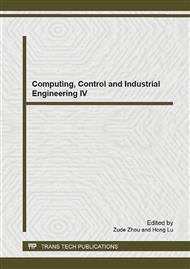[1]
Qi Ying, Predetermination and application of Linear Exponential Smoothing Model, Journal of Being Institute of Machinery, 4th., vol. 19, pp.50-55, (2011).
Google Scholar
[2]
BI Lei, XIAO Ben-xian, YU Hai-bin , Contour error compensating method based on Linear exponential smoothing model prediction technique, JOURNAL OF HEFEI UNIVERSITY OF TECHNOLOGY , 4th., vol. 19, pp.1166-1170, (2010).
Google Scholar
[3]
Wang Bo, Hu Xiang-yong, Lin Tian-bao, An Improvement of Single-Index Moving Method with Fuzzy Set Theory, J . of Univ . of Hydr . & Elec . Eng . /Yichang, 2nd., vol. 21, pp.133-136, (1999).
Google Scholar
[4]
H ESEN, F OZGEN, M ESEN, Modeling of a new solar air heater through least square support vector machine, Expert Systems with Applications, 7th., vol. 36, pp.10673-10682, (2010).
DOI: 10.1016/j.eswa.2009.02.045
Google Scholar
[5]
LI Hong-ze, GUO Sen, LI Chun-jie, A Hybrid Forecasting Model Based on Fruit Fly Optimization Algorithm and Least Squares Support Vector Machine: -the Case of Logistics Demand Forecasting of China, JOURNAL OF QUANTITATIVE ECONOMICS, 3rd., vol. 29, pp.103-106, (2012).
DOI: 10.3390/en5114430
Google Scholar
[6]
K. Tomsovic, A fuzzy linear programming approach to the reactive power/voltage control problem, IEEE Trans. on Power Systems, 1st., vol. 7, pp.287-293.
DOI: 10.1109/59.141716
Google Scholar
[7]
LI Xiu-qing, WANG Tao, WANG Kai, et al. A hybrid strategy based on ACO and IPM for optimal reactive power flow, 1st., Relay, vol. 36, pp.22-26.
Google Scholar
[8]
Dommel H, Tinney W F, Optimal power flow solutions, IEEE Transactions on Power Apparatus and Systems, 10th., vol. 87, pp.1866-1876.
DOI: 10.1109/tpas.1968.292150
Google Scholar
[9]
XU Jin-dong, DING Xiao-qun, QIN Zhen-cheng, et al. A nonlinear predictor-corrector interior point method for reactive power optimization in power system, Power System Technology, 9th., vol. 29, pp.36-40, (2005).
Google Scholar
[10]
WANG Cheng-shan, ZHANG YI, Optimal reactive power planning using Bender's decomposition of the CSU-EPSA, 4th., vol. 5, pp.47-50, (2003).
Google Scholar


